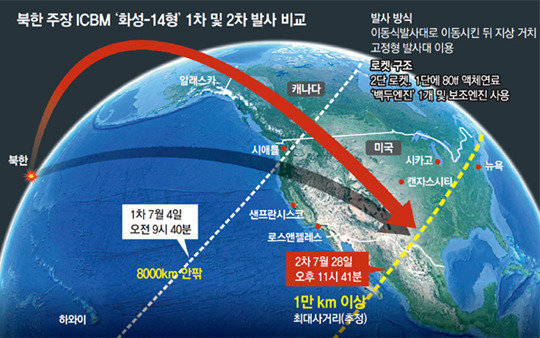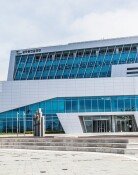N. Korea’s ICBM-class missile includes Chicago within striking range
N. Korea’s ICBM-class missile includes Chicago within striking range
Posted July. 31, 2017 07:40,
Updated July. 31, 2017 08:13

North Korea claimed that the warhead segment of the Hwasong-14 ballistic missile successfully reentered the atmosphere in the second round launch on Friday again after the first round launch on July 4. However, watchers are suspicious about it, because the technology for the reentry vehicle is difficult to be validated through a high-angle launch. If one fires an ICBM at a normal firing angle, the speed of the missile at the time of reentry into the atmosphere is more than 20 times the speed of sound. The missile must also withstand ultrahigh temperatures of 6,000 – 7,000 degrees Celsius, high pressure and impact. The core element of reentry technology is for the warhead loaded with nuclear materials and detonator to endure extreme conditions and seamlessly reach the ground target. “If one fires an ICBM at a high angle, a significant portion of the engine’s thrust is wasted in overcoming the gravity, and as a result the missile’s descending speed significantly declines,” a source in the South Korean military said. If the speed of reentry into the atmosphere is low, the heat and pressure also decline in tandem, which makes it difficult to validate the technology for the reentry vehicle.
However, other watchers say the world should not underestimate the North’s capability. Considering the technological capability of North Korea that made all-in bet in the development of nuclear weapons and missiles for more than two decades, we cannot rule out the probability that Pyongyang has entered the final phase in the development of reentry technology. Those watchers say that with the North reportedly having achieved the miniaturization of a nuclear warhead already or come very close to this goal, Pyongyang could only have the final ‘1 percent to go before completion’ in its effort to perfect technology for an ICBM’s reentry into the atmosphere. This is evidenced by the fact that the pace of the North’s submarine-launched ballistic missile (SLBM) development has been significantly accelerated in defiance of forecasts by the South Korean and U.S. military authorities. “We have to prepare ourselves for a scenario in which the North completes reentry technology for the Hwasong-14 type missiles through two to three additional launches within one to two years, and declares production and deployment to actual combat mission,” a South Korean military source said.
hjson@donga.com · ysh1005@donga.com
Headline News
- N. Korea launches cyberattacks on S. Korea's defense companies
- Major university hospital professors consider a day off each week
- Italy suffers from fiscal deficits from ‘Super Bonus’ scheme
- Inter Milan secures 20th Serie A title, surpassing AC Milan
- Ruling and opposition prioritize spending amid tax revenue shortfalls







